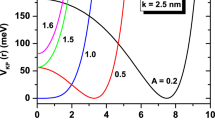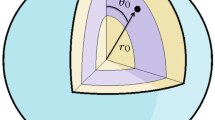Abstract
We investigated the effect of the number of wells and quantum dot radius on the dipole matrix elements and optical properties of three electrons confined in concentric multishell quantum dots, comparing two different semiconducting compound nanostructures: \(\hbox {GaAs/Ga}_{{x}}\hbox {Al}_{{(1-x)}}\hbox {As}\) and InGaAs/InAlAs. We used a high-accuracy interpolation-based 14-point finite difference method to solve the corresponding Schrodinger equation. The results showed that, although InGaAs/InAlAs multishell quantum dots have lower absorption peak heights than the \(\hbox {GaAs/Ga}_{{x}}\hbox {Al}_{{(1-x)}}\hbox {As}\) ones, the effects of the quantum dot radius and number of wells on the optical properties are more intense in the studied InGaAs/InAlAs structures. Therefore, since a wider absorption peak height range can be spanned when using the InGaAs/InAlAs system, these structures are more tunable, which could facilitate selection of desired systems by experimentalists.




Similar content being viewed by others
References
Reimann, S.M., Manninen, M.: Electronic structure of quantum dots. Rev. Mod. Phys. 74, 1283–1342 (2002)
Kouwenhoven, L.P., Austing, D.G., Tarucha, S.: Few-electron quantum dots. Rep. Prog. Phys. 64, 701–736 (2001)
Bratschitsch, R., Leitenstorfer, A.: Quantum dots: artificial atoms for quantum optic. Nat. Mater. 5, 855–856 (2006)
Schedelbeck, G.: Coupled quantum dots fabricated by cleaved edge overgrowth: from artificial atoms to molecules. Science 278, 1792 (1997)
Hada, Y., Eto, M.: Electronic states in silicon quantum dots: multivalley artificial atoms. Phys. Rev. B 68, 155322–155322-7 (2003)
Fujisawa, T., Oosterkamp, T.H., van der Wiel, W.G., Broer, B.W., Aguado, R., Tarucha, S., Kouwenhoven, L.P.: Spontaneous emission spectrum in double quantum dot devices. Science 282, 932–935 (1998)
Gammon, D.: Electrons in artificial atoms. Nature 405, 899–900 (2000)
Prudente, F.V., Costa, L.S., Vianna, J.D.M.: A study of two-electron quantum dot spectrum using discrete variable representation method. J. Chem. Phys. 123, 224701–224701-11 (2005)
Li, Y., Yannouleas, C., Landman, U.: Three-electron anisotropic quantum dots in variable magnetic fields: exact results for excitation spectra, spin structures, and entanglement. Phys. Rev. B 76, 245310–245310-12 (2007)
Tavernier, M.B., Anisimovas, E., Peeters, F.M., Szafran, B., Adamowski, J., Bednarek, S.: Four-electron quantum dot in a magnetic field. Phys. Rev. B 68, 205305–205305-9 (2003)
Mikhailov, S.A.: Few-electron quantum dots and disks in zero magnetic field: possible indications on a liquid–solid transition. Physica E 12, 884–887 (2002)
Szafran, B., Bednarek, S., Adamowski, J.: Magnetic-field-induced transformations of Wigner molecule symmetry in quantum dots. Phys. Rev. B 67, 045311–045311-4 (2003)
Garcia-Castelan, R.M.G., Choe, W.S., Lee, Y.C.: Correlation energies for two interacting electrons in a harmonic quantum dot. Phys. Rev. B 57, 9792–9806 (1997)
Simonovic, N.S., Nazmitdinov, R.G.: Dynamical screening of the Coulomb interaction for two confined electrons in a magnetic field. Phys. Rev. A 78, 032115–032115-10 (2008)
Huang, J., Libin: Dipole-allowed optical absorption in a parabolic quantum dot with two electrons. Phys. Lett. A 372, 4323–4326 (2008)
Xie, W.: Linear and nonlinear optical absorptions of a two-electron quantum dot. Phys. B 405, 2102–2106 (2010)
Lu, L., Xie, W.: Electric field effects on the intersubband optical absorptions and refractive index in double-electron quantum dots. Phys. Scr. 84, 025703–025707-7 (2011)
Fang, A., Chi, X., Sheng, P.: Ground and excited states of three-electron quantum dots. Solid State Commun. 142, 551–555 (2007)
Hassanabadi, H., Rahimov, H., Zarrinkamar, S.: Rashba coupling in three-electron-quantum dot under cylindrical symmetry: an exact solution. Ann. Phys. 326, 2957–2962 (2011)
Çakr, B., Yakar, Y., Özmen, A., Özgür Sezer, M., Sahin, M.: Linear and nonlinear optical absorption coefficients and binding energy of a spherical quantum dot. Superlatt. Microstruct. 47, 556–566 (2010)
Zhang, C.-J., Guo, K.-X.: Polaron effects on the third-order nonlinear optical susceptibility in asymmetrical semi-parabolic quantum wells. Phys. B 383, 183–187 (2006)
Wang, G., Guo, K.: Excitonic effects on the third-harmonic generation in parabolic quantum dots. J. Phys.: Condens. Matter 13, 8197–8206 (2001)
Adamowski, J., Sobkowicz, M., Szafran, B., Bednarek, S.: Electron pair in a Gaussian confining potential. Phys. Rev. B 62, 4234–4237 (2000)
Palacios, J.J., Hawrylak, P.: Correlated few-electron states in vertical double-quantum-dot systems. Phys. Rev. B 51, 1769–1777 (1995)
Daia, Z.H., Zhang, L.D., Sun, J.Z., Li, Z.H., Huangb, S.Y.: Few-electron filling effect in laterally coupled spherical InAs/GaAs quantum-dot system. Appl. Phys. Lett. 80, 2577–2579 (2002)
Pujari, B., Joshi, K., Kanhere, D.G., Blundell, S.A.: Electronic structure of many-electron square-well quantum dots with and without an attractive impurity: spin-density-functional theory. Phys. Rev. B 76, 085340–085340-10 (2007)
Szafran, B., Adamowski, J., Bednarek, S.: Few-electron systems in quantum cylinders. Phys. Rev. B 61, 1971–1977 (2000)
Rontani, M., Cavazzoni, C., Bellucci, D., Goldoni, G.: Full configuration interaction approach to the few-electron problem in artificial atoms. J. Chem. Phys. 124, 124102–124102-14 (2006)
Maksym, P.A., Chakraborty, T.: Quantum dots in a magnetic field: role of electron–electron interactions. Phys. Rev. Lett. 65, 108–111 (1990)
Mikhailov, S.A.: Quantum-dot lithium in zero magnetic field: electronic properties, thermodynamics, and Fermi liquid–Wigner solid crossover in the ground state. Phys. Rev. B 65, 115312–115312-12 (2002)
Mikhailov, S.A., Savostianova, N.A.: Depolarization of electron spins by a magnetic field quantum-dot lithium in the strong-interaction regime. Phys. Rev. B 66, 033307–033307-4 (2002)
Wensauer, A., Steffens, O., Suhrke, M., Rossler, U.: Laterally coupled few-electron quantum dots. Phys. Rev. B 62, 2605–2613 (2000)
Sullivana, D., Citrinb, D.S.: Time-domain simulation of two electrons in a quantum dot. J. Appl. Phys. 89, 3841–3846 (2001)
Lozovik, Y.E., Volkov, SYu., Willander, M.: Crystallization and quantum melting of few electron system in a spherical quantum dot: quantum Monte Carlo simulation. Solid State Commun. 125, 127–131 (2003)
Balzer, K., Bonitz, M., van Leeuwen, R., Stan, A., Dahlen, N.E.: Nonequilibrium Green’s function approach to strongly correlated few-electron quantum dots. Phys. Rev. B 79, 245306–245306-13 (2009)
Hassanabadi, H., Rahimov, H.: An alternative method for spectrum of a three-electron-quantum dot. Phys. B 406, 3070–3073 (2011)
Hassanabadi, H., Hamzavi, M., Zarrinkamar, S., Rajabi, A.A.: Quadratic and coulomb terms for the spectrum of a three-electron quantum dot. Few-Body Syst. 48, 53–58 (2010)
Yannouleas, C., Landman, U.: Symmetry breaking and quantum correlations in finite systems: studies of quantum dots and ultracold Bose gases and related nuclear and chemical methods. Rep. Prog. Phys. 70, 2067–2148 (2007)
Yannouleas, C., Landman, U.: Collective and independent-particle motion in two-electron artificial atoms. Phys. Rev. Lett. 85, 1726–1729 (2000)
Taut, M.: Distortion of Wigner molecules: a pair function approach. J. Phys.: Condens. Matter 21, 075302–075302-10 (2009)
Ahn, D., Chuang, S.L.: Calculation of linear and nonlinear intersubband optical absorptions in a quantum well model with an applied electric field. IEEE J. Quantum Electron. QE–23, 2196–2204 (1987)
Adachia, S.: GaAs, AlAs, and AlxGa1-xAs: material parameters for use in research and device applications. J. Appl. Phys. 58, R1–R29 (1985)
Solaimani, M., Izadifard, M., Arabshahi, H., Sarkardei, M.R.: Study of optical non-linear properties of a constant total effective length multiple quantum wells system. J. Lumin. 134, 699–705 (2013)
Susa, N.: Electric-field-induced refractive index changes in InGaAs–InAlAs asymmetric coupled quantum wells. IEEE J. Quant. Electron. 31, 92–100 (1995)
Li, S.-S., Xia, J.-B.: Linear Rashba model of a hydrogenic donor impurity in GaAs/GaAlAs quantum wells. Nanoscale Res. Lett. 4, 178–180 (2009)
Huang, Y., Wang, J., Lien, C.: Electric field dependence of optical absorption properties in coupled quantum wells and their application to \(1.3\,\upmu \text{ m }\) optical modulator. J. Appl. Phys. 77, 11–16 (1995)
Acknowledgements
The authors acknowledge funding for this work from the Iran National Science Foundation (INSF) through research project no. 94010730.
Author information
Authors and Affiliations
Corresponding author
Rights and permissions
About this article
Cite this article
Solaimani, M. Intersubband optical properties of three electrons confined in multishell quantum dots: comparison of two semiconducting compounds. J Comput Electron 17, 1135–1142 (2018). https://doi.org/10.1007/s10825-018-1187-8
Published:
Issue Date:
DOI: https://doi.org/10.1007/s10825-018-1187-8




